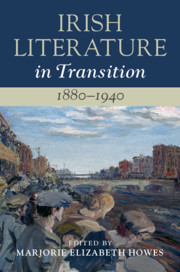Book contents
- Irish Literature in Transition, 1880–1940
- Irish Literature In Transition
- Irish Literature in Transition, 1880–1940
- Copyright page
- Contents
- Contributors
- Series Preface
- General Acknowledgements
- Chapter 1 Introduction
- Part I Revisionary Foundations
- Part II Revolutionary Forms
- Chapter 6 Print Culture Landscapes 1880–1922
- Chapter 7 Revolutionary Lives in the Rearview Mirror: Memoir and Autobiography
- Chapter 8 The Hugh Lane Controversy and the Irish Revival
- Chapter 9 New Irish Women and New Women’s Writing
- Part III Major Figures in Transition
- Part IV Aftermaths and Outcomes
- Part V Frameworks in Transition
- Index
Chapter 6 - Print Culture Landscapes 1880–1922
from Part II - Revolutionary Forms
Published online by Cambridge University Press: 28 February 2020
- Irish Literature in Transition, 1880–1940
- Irish Literature In Transition
- Irish Literature in Transition, 1880–1940
- Copyright page
- Contents
- Contributors
- Series Preface
- General Acknowledgements
- Chapter 1 Introduction
- Part I Revisionary Foundations
- Part II Revolutionary Forms
- Chapter 6 Print Culture Landscapes 1880–1922
- Chapter 7 Revolutionary Lives in the Rearview Mirror: Memoir and Autobiography
- Chapter 8 The Hugh Lane Controversy and the Irish Revival
- Chapter 9 New Irish Women and New Women’s Writing
- Part III Major Figures in Transition
- Part IV Aftermaths and Outcomes
- Part V Frameworks in Transition
- Index
Summary
Writing in 1894 in the American journal The Outlook: A Family Magazine, the Irish poet and novelist Katharine Tynan identified the Irish Literary Revival as a distinctive movement within the wider trends of English literature. For her, the Revival had begun with the Gaelic poetry that ‘had been exquisitely translated into English by Edward Walsh, Ferguson, Mangan, Callanan, and others, thirty or forty years ago’, and had reached its zenith with the publication of Douglas Hyde’s Love Songs of Connaught (1893), a collection that brought ‘fresh and exquisite earth-songs’ to a wider English audience than the previous Revival poets had been able to capture.
- Type
- Chapter
- Information
- Irish Literature in Transition, 1880–1940 , pp. 97 - 113Publisher: Cambridge University PressPrint publication year: 2020
- 1
- Cited by

